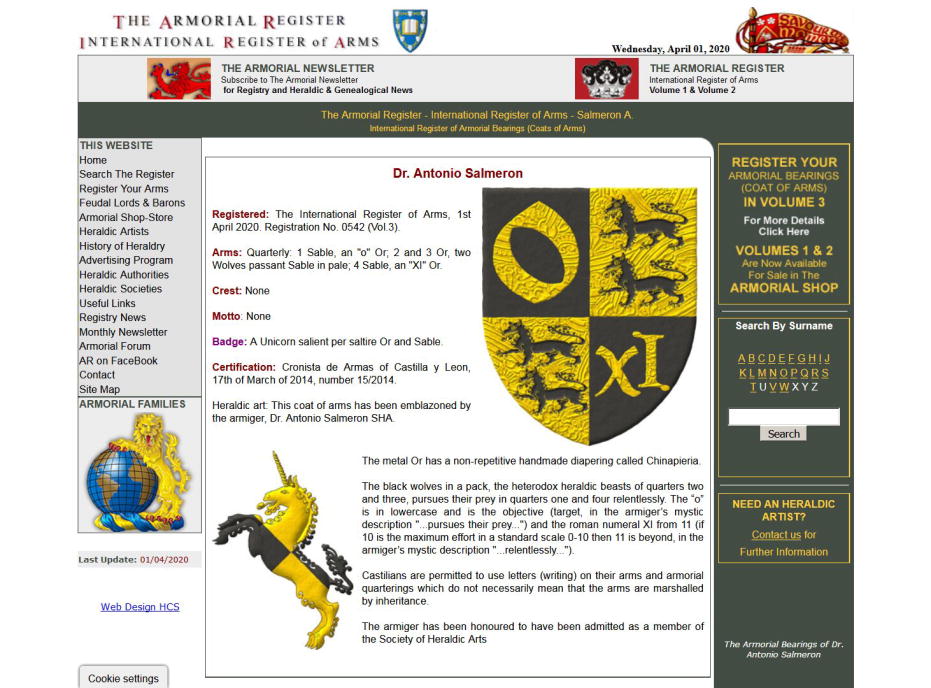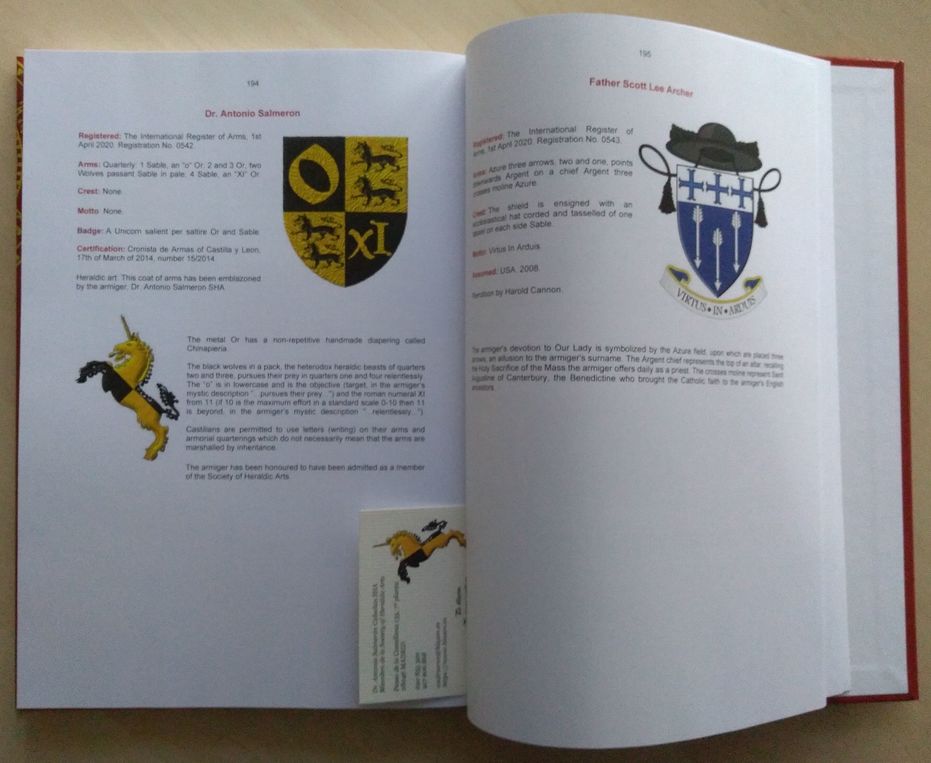
![Ver [The Heraldry Society; 2018] en referencias bibliográficas. Libro abierto, hojas de plata, filo de oro, guardas de gules, tapas de sable.](../css/Libro.Bibliografia.png)
The Heraldry Society; 2018
The Heraldry Society, «Historic Heraldry Handbook», Baldock, Hertfordshire, 2018.
Bibliographical reference of century XXI.
Classification: In color.
The author is The Heraldry Society.
External resource:
Internal resources: TheHeraldrySociety2018.HistoricHeraldryHandbook.pdf.


![Ver [Bravo Guarida, C.; 1934] en referencias bibliográficas. Libro abierto, hojas de plata, filo de oro, guardas de gules, tapas de sable.](../css/Libro.Bibliografia.png)
Bravo Guarida, C.; 1934
Clemente Bravo Guarida, «El Paso Honroso de Don Suero de Quiñones: Célebre Caballero Leonés en el Puente de Órbigo, en 1434», second edition, published by «El Diario de León» to commemorate the fifth centenary of this famous feat of arms, 59 pages, printed by Imprenta Católica, León, 1934.
This edition, written by Clemente Bravo Guarida, provides an updated account of the famous «Passo Honroso», [Rodríguez de Lena, P.; Century XVI], undertaken by the renowned knight Suero de Quiñones in 1434 at the bridge of Órbigo.
The book includes the full list of the 10 maintainers on page 57, and the 68 challengers, or adventurers, on pages 67 and 68. It also reports the results of the jousts for all participants.
Please note a correction: on page 58, where it reads «Loque de la Torre, corrió 6, rompió 4» it should instead say «Lope de la Torre, corrió 6, rompió 4».
Bibliographical reference of century XX.
Classification: Castilian language and In black and white.
Author: Bravo Guarida, Clemente.
Bibliographical reference mentioned in the following article:
Internal resources: BravoGuaridaC1934.PasoHonroso.Ocr.pdf.


Cristina, The Knights of
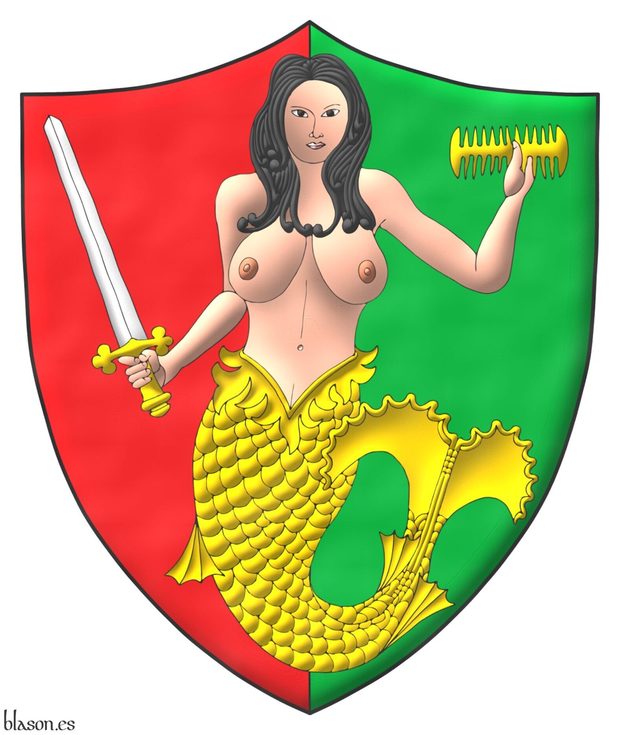
Party per pale Gules and Vert; overall a mermaid proper, holding in her dexter a sword Argent, hilted Or, and in her sinister a comb Or.
Escudo partido de gules y sinople; brochante sobre la partición una sirena al natural, teniendo en su diestra una espada de plata, guarnecida de oro, y en su siniestra un peine de oro.
Coat of arms designed by me, highlighted with lights and shadows, contoured in Sable, and with a watercolor finishing.
Coat of arms of The Knights of Cristina designed under her directions and emblazoned by me.
Blazon keywords: Gules, Vert, Argent, Or, One, Party per pale, Overall, Mermaid, Proper, Grasping, Dexter, Sword, Hilted, Sinister and Comb.
Style keywords: Outlined in sable, Illuminated and Watercolor.
Classification: Imaginary, Created, Boa and Coat of arms.
Imaginary bearer: Cristina, The Knights of.


The Knights of Cristina
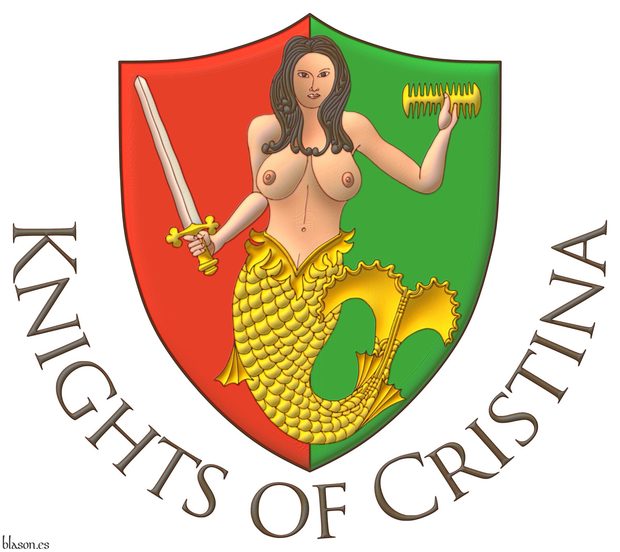
Party per pale Gules and Vert; overall a mermaid proper, holding in her dexter a sword Argent, hilted Or, and in her sinister a comb Or. Motto: «Knights of Cristina».
Escudo partido de gules y sinople; brochante sobre la partición una sirena al natural, teniendo en su diestra una espada de plata, guarnecida de oro, y en su siniestra un peine de oro. Divisa: «Knights of Cristina».
Coat of arms designed by me, highlighted with lights and shadows, contoured in Sable, and with a forge finish.
Blazon keywords: Gules, Vert, Argent, Or, One, Party per pale, Overall, Mermaid, Proper, Grasping, Dexter, Sword, Hilted, Sinister, Comb and Motto.
Style keywords: Outlined in sable, Illuminated and Forge.
Classification: Imaginary, Created, Boa and Coat of arms.
Imaginary bearer: Cristina, The Knights of.


Badge of The Knights of Cristina
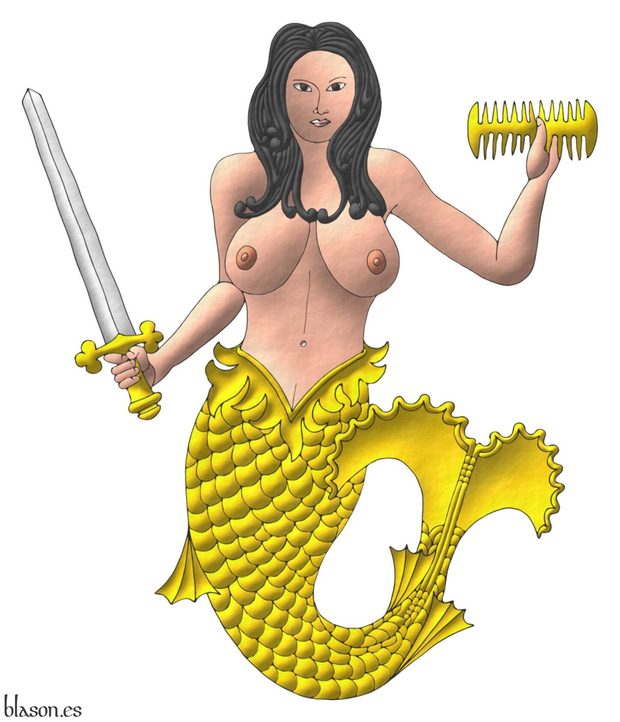
A mermaid proper, holding in her dexter a sword Argent, hilted Or, and in her sinister a comb Or.
Heraldic device designed by me, highlighted with lights and shadows, contoured in Sable, and with a rough finishing.
The heraldic badge of The Knights of Cristina designed under her directions and emblazoned by me.
Blazon keywords: Argent, Or, One, Mermaid, Proper, Grasping, Dexter, Sword, Hilted, Sinister and Comb.
Style keywords: Outlined in sable, Illuminated and Rough.
Classification: Imaginary, Created, Boa and Badge.
Imaginary bearer: Cristina, The Knights of.


![Ver [Rumor, S.; 1899] en referencias bibliográficas. Libro abierto, hojas de plata, filo de oro, guardas de gules, tapas de sable.](../css/Libro.Bibliografia.png)
Rumor, S.; 1899
Sebastiano Rumor, «Il Blasone Vicentino Descritto ed Illustrato», published by Venezia, A spese della Società, 310 pages of black and white text, 20 color plates, including: 1 plate at the beginning with 10 coats of arms, and 19 plates at the end, each containing 6 coats of arms, totaling 124 coats of arms, Venice, 1899.
Bibliographical reference of century XIX.
Classification: Italian language and Black and white with color plates.
Author: Rumor, Sebastiano.
External link:
Internal resources: RumorS1899.IlBlasoneVicentino.pdf PDF format.

![Ver [Labandeira Fernández, A.; 1977] en referencias bibliográficas. Libro abierto, hojas de plata, filo de oro, guardas de gules, tapas de sable.](../css/Libro.Bibliografia.png)
Labandeira Fernández, A.; 1977
Amancio Labandeira Fernández, «The Passo Honroso of Suero de Quiñones. Introduction and edition by Amancio Labandeira Fernández», 438 pages, 24 plates, 8 genealogical trees, Fundación Universitaria Española, Collection Clásicos Olvidados of Espasa-Calpe, Madrid, 1977.
This edition, written by Clemente Bravo Guarida, provides an updated account of the famous «Passo Honroso», based on [Rodríguez de Lena, P.; Century XVI], undertaken by the renowned knight Suero de Quiñones and his 9 companions against 68 knights in 1434 at the bridge of Órbigo.
Bibliographical reference of century XX.
Classification: Castilian language.
Author: Labandeira Fernández, Amancio.


Antonio Salmeron, The Armorial Register
Registered by The International Register of Arms, 1st of April of 2020, Registration number 0542, Volume 3.
[Armorial Register, T.; 2020; page 194].
Categories: Armorial roll, Quarterly, Or, Sable, Two, Wolf and Passant.
External resource:
Root: The Armorial Register.

Continue with: Ackerson - Akers, lineage.
-
Language
-
Categories of heraldry
-
Divisions of the field
- Without divisions
- Party per pale
- Party per fess
- Party per bend
- Party per bend sinister
- Tierce
- Tierce sinister
- Tierced per pale
- Tierced per fess
- Tierced per bend
- Tierced pallwise inverted
- Quarterly
- Quarterly per saltire
- Gyronny
- Party per fess, the chief per pale
- Party per pale, the sinister per fess
- Party per fess, the base per pale
- Party per pale, the dexter per fess
- Chapé
- Chaussé
- Embrassé
- Contre-embrassé
- Party per chevron
- Enté
- Enté en point
- Flanched
-
Metals
-
Colours
-
Furs
-
Other tinctures
-
Ordinaries and sub-ordinaries
-
Diminutives of the ordinaries
-
Geometric charges
-
Composite ordinaries
-
Inanimate charges from Nature
Atom, Crescent, Diamond, Emerald, Estoile, Increscent, Lightning flash, Moon, Mount, Mullet, Mullet of four points, Orbital, Plough of Ursa Major, Rainbow, Ray of the sun, River, Sea, Snowflake, Sun, Sun in splendour, Sun of May, Trimount, Water and Wave.
-
Vegetal charges from Nature
Acorn, Apple, Apple tree, Ash, Bluebonnet, Camellia, Chrysanthemum, Cinquefoil, Cornflower, Dogwood flower, Double rose, Elm, Fleur de lis, Flower, Gourd, Holm oak, Hop cone, Kapok tree, Laurel, Lily, Linden, Lotus flower, Madonna lily, Mexican cedar tree, Oak, Olive tree, Palm tree, Plantain plant, Pomegranate, Poplar leaf, Rose, Shamrock, Sunflower, Thistle, Tree, Tulip, Vine and Wheat.
-
Animal charges from Nature
Badger, Bald eagle, Barbel, Barn owl, Bear, Beaver, Beetle, Bighorn sheep, Blackbird, Boar, Brach hound, Bull, Doe, Dog, Dolphin, Dove, Eagle, Elephant, Falcon, Female figure, Fish, Flame, Fly, Fox, Frog, Goat, Goldfinch, Goose, Heron, Horse, Hummingbird, Jaguar, Lark, Leopard, Lion, Lion passant, Lion rampant guardant, Lioness, Lynx, Male figure, Martlet, Merino ram, Owl, Panther, Parrot, Peacock, Pelican, Pelican in her piety, Puffin, Quetzal, Raven, Roe deer, Rooster, Savage, Seagull, Serpent, She-wolf, Stag, Starling, Talbot, Tyger, Vulture, Warren hound and Wolf.
-
Parts of natural charges
Arm, Beak, Branch, Caboshed, Chest, Claw, Covert, Dorsal fin, Eagle claw, Ermine spot, Escallop, Feather, Foot (palmiped), Foreleg, Forepaw, Hand, Head, Heart, Hoof, Leaf, Neck, Ostrich feather, Palm frond, Paw, Roe deers' attires, Shoulder, Sprig, Stags' attires, Stem, Swallow-tail, Tail, Tail addorsed, Tail fin, Talon, Tibia, Tooth, Trunk, Trunk (elephant), Two hands clasped, Two wings in vol, Udder, Wheat spike, Wing and Wrist.
-
Artificial charges
Ace of spades, Anchor, Anvil, Arch, Arm vambraced, Armillary sphere, Arrow, Axe, Bell, Bell tower, Beret, Bonfire, Book, Bookmark, Bow, Branding iron, Bridge, Broken, Buckle, Cannon, Cannon dismounted, Cannon port, Canopy roof, Carbuncle, Castle, Celtic Trinity knot, Chain, Chess rooks, Church, Clarion, Clay pot, Closed book, Club, Column, Comb, Compass rose, Conductor's baton, Cord, Covered cup, Crozier, Crucible, Cuffed, Cup, Cyclamor, Dagger, Double vajra, Drum, Ecclesiastical cap, Fanon, Federschwert, Fleam, Four crescents joined millsailwise, Galician granary, Garb, Gauntlet, Geometric solid, Grenade, Halberd, Hammer, Harp, Host, Hourglass, Key, Key ward, Knight, Knot, Lantern, Letter, Line, Loincloth, Menorah, Millrind, Millstone, Millwheel, Monstrance, Mortar, Mullet of six points pierced, Nail, Non-classic artifact, Norman ship, Number, Oar, Oil lamp, Open book, Page, Pair of scales, Parchment, Pestle, Piano, Pilgrim's staff, Plough share, Polish winged hussar, Port, Portcullis, Potent, Quill, Ribbon, Rosette of acanthus leaves, Sabre, Sackbut, Sail, Scroll, Scythe, Sheaf of tobacco, Ship, Skirt, Spear, Spear's head, Stairway, Star of David, Step, Sword, Symbol, Tetrahedron, Torch, Tower, Trident, Trumpet, Turret, Two-handed sword, Wagon-wheel, Water-bouget, Wheel, Winnowing fan and With a turret.
-
Immaterial charges
Angel, Archangel, Basilisk, Dragon, Dragon's head, Garuda, Golden fleece, Griffin, Heart enflamed, Justice, Mermaid, Our Lady of Mercy, Ouroboros, Paschal lamb, Pegasus, Phoenix, Sacred Heart of Jesus, Saint George, Sea-griffin, Trinity, Triton, Unicorn, Winged hand and Wyvern.
-
External elements
-
Heraldic creations
-
References
-
Formats
-
Keywords on this page
Between, Watercolor, Proper, Armorial roll, Bend, Acorn, Bibliography, Boa, Overall, Created, Cristina, The Knights of, Quarterly, Outlined in sable, Dexter, Two, In black and white, Black and white with color plates, In color, Coat of arms, Sword, Forge, Hilted, Gules, Illuminated, Imaginary, Badge, Interpreted, Motto, Castilian language, Italian language, Wolf, Ordered, Or, Party per pale, Passant, Comb, Argent, Rough, Sable, Century XIX, Century XX, Century XXI, Sinister, Vert, Mermaid, Grasping, The Armorial Register, Freehand and One.

